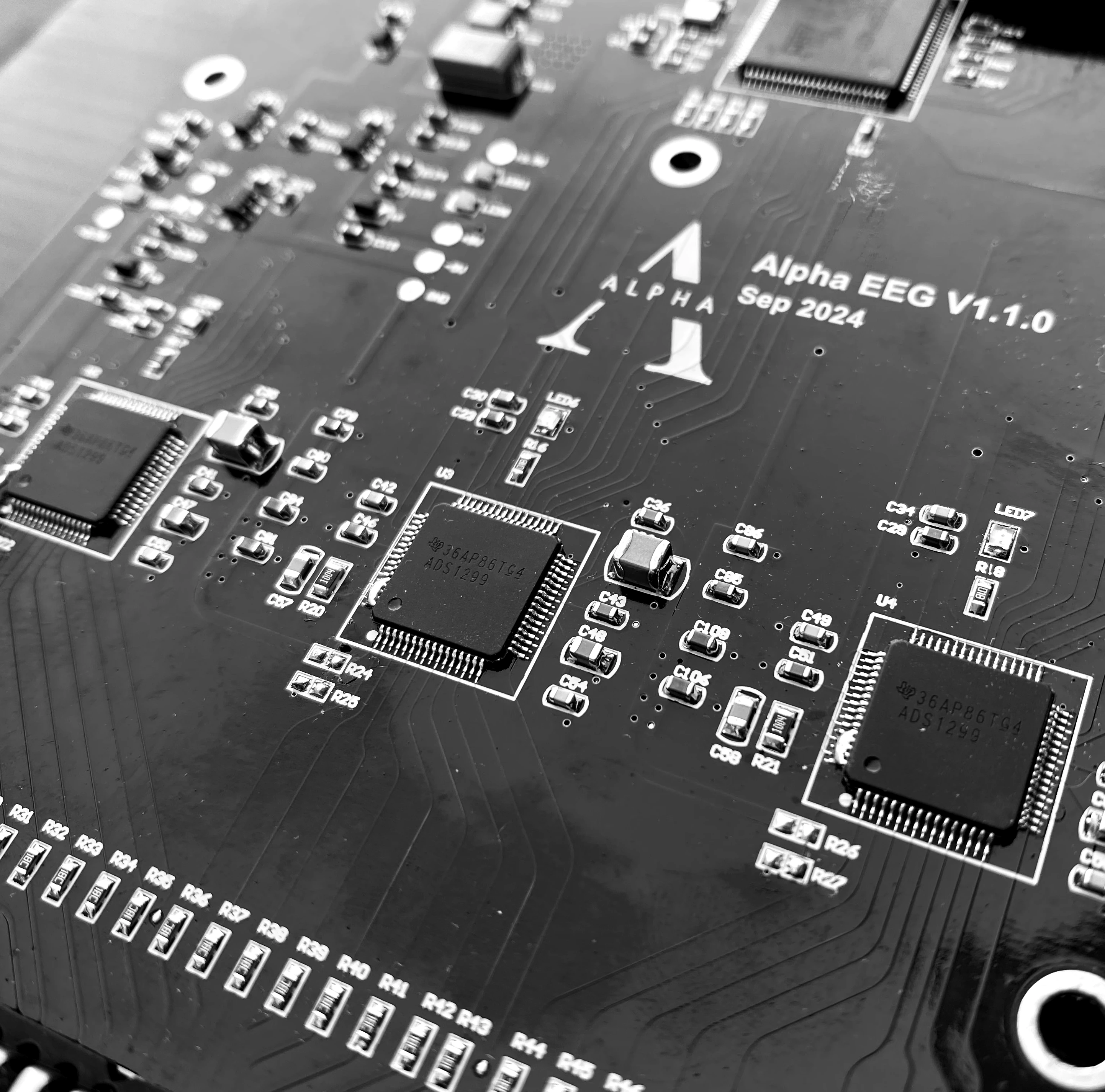آلفا | دستگاه EEG و نقشهبرداری مغزی پیشرفته
دستگاه نقشه مغزی آلفا طراحی شده تا استانداردهای جدیدی در دقت و کیفیت نقشهبرداری مغزی ایجاد کند. این دستگاه با بهرهگیری از آی سی (ADS1299) از کمپانی TI و ریز پردازنده فوق العاده قدرتمند خود (STMF407)، دادههای مغزی را با وضوحی بینظیر ثبت و تحلیل میکند؛ چیزی فراتر از آنچه در تجهیزات مشابه تجربه کردهاید.
با دستگاه QEEG آلفا، نه تنها تصویری شفافتر از فعالیتهای مغزی در اختیار دارید، بلکه تحلیلهای هوشمند و قابل اعتماد نیز در لحظه ارائه میشوند. ترکیب دقت سختافزاری و تحلیل قدرتمند نرم افزاری، آلفا را به انتخابی مطمئن برای کلینیکها، مراکز تحقیقاتی و متخصصان حوزه علوم اعصاب تبدیل کرده است.

ویژگی های دستگاه نقشه مغزی آلفا
Robust Design
طراحی مهندسیشده مدار در دستگاه QEEG آلفا باعث کاهش حداکثری تداخل سیگنال و ثبت همزمان دقیق میشود. این معماری اصولی، کیفیت بالای سیگنال را در هر شرایطی تضمین میکند.
Ultra-low Noise
در آلفا منابع نویز از همان مبدا حذف شدهاند. بنابراین سیگنالها با کیفیت بالا ثبت میشوند و نیاز به فیلترینگ سنگین در پردازش به حداقل میرسد.
Accurate Signal
سیگنالهای دقیق و شفاف در کوتاهترین زمان به نرم افزار آلفا منتقل میشوند؛ ایدهآل برای استفاده در فرآیندهای کلینیکی و تحقیقات علمی.
Best for Clinical Use
آلفا با کاربری ساده، نصب آسان و طراحی متناسب با نیازهای درمانگران ساخته شده است. هر جزئیات دستگاه با در نظر گرفتن شرایط واقعی کلینیک طراحی شده است.
Advanced Manufacturing
دستگاه نقشه مغزی آلفا با بهرهگیری از تکنیکهای پیشرفته مونتاژ و کنترل کیفیت تولید میشود؛ این فرآیندها خطای انسانی را کاهش داده و حداکثر اطمینان از کیفیت را ایجاد میکنند.
Original Parts
استفاده از قطعات اورجینال و باکیفیت، دوام طولانیمدت و عملکرد پایدار دستگاه نقشه مغزی آلفا را برای سالها تضمین میکند

نوآوری در طراحی مدار؛ قلب دستگاه QEEG آلفا
دستگاه نقشهمغزی آلفا با طراحی اختصاصی و پیشرفته، سیگنالهای مغزی را با بالاترین کیفیت و کمترین نویز – در سطح دستگاههای کلاس A جهانی – ثبت میکند. بهرهگیری از فناوریهای روز و قطعات اورجینال، آلفا را به انتخابی مطمئن برای کلینیکهای تخصصی و مراکز تحقیقاتی تبدیل کرده است.
سیگنال پایدار و تمیز
طراحی خاص بورد الکترونیکی، ثبت سیگنالهای دقیق و بدون تداخل را تضمین میکند
پردازش دقیق و سریع سیگنال
پردازندهی قدرتمند TI، امکان پردازش لحظه ای و دقیق سیگنالها را فراهم میکند.
ایزوله کردن قطعات حساس
ماژولار بودن و ایزولهسازی بخشهای حساس، کیفیت سیگنال را در بالاترین سطح حفظ میکند.
پرفورمنس بالای مدار
سرعت نمونهبرداری بالا همراه با نویز حداقلی، راندمان کلینیکی دستگاه را تضمین مینماید.
حداقل تداخل سیگنالها
بهکارگیری Op-Amp با نویز پایین و CMRR بالا، تداخل بین کانالها را به حداقل میرساند.
کمترین نویز دریافتی
گراندینگ هوشمند و طراحی دقیق فیلترهای Notch و Bandpass، دریافت سیگنال خالص مغز را ممکن میکند.
| Feature | Value |
|---|---|
Noise Level | 0.3 µV rms |
SNR | 121 dB |
Sample Rate | 250 - 2K |
EEG Channels | 21 Channels |
Gain | 24 PGA |
Extra Channels | 3 CH |
Interface | USB |
Power Input Voltage | 0 – 5 V |
Bandwidth | 0.05 – 80 Hz |
CMRR | > 100 dB |
Resolution | 24 Bit |
Input Impedance | >1 GOhm |
High Performance
High CMRR (>100 dB) & High resolution (24 Bit)
Signal Quality
High SNR (121 dB) & Ultra low noise level (0.3 µV)
Measurable Range
Broad Bandwidth (0.05 – 80 Hz)
اطلاعات بیشتر درباره پارامترهای فنی
شناخت شاخصهای اصلی که عملکرد یک سیستم EEG را تعریف میکنند.
نرخ نمونهبرداری (Sample Rate) در واقع تعیین میکند که دستگاه EEG/QEEG در هر ثانیه چند بار سیگنال مغزی را ثبت میکند. هرچه این عدد بالاتر باشد (مثلاً تا 2048 هرتز)، جزئیات بیشتری از نوسانهای مغزی بهدست میآید و احتمال از دست رفتن تغییرات سریع کاهش پیدا میکند. در مقابل، اگر نرخ نمونهبرداری پایین باشد، بخشی از اطلاعات از بین میرود و دقت نقشه مغزی یا تفسیر بالینی کمتر میشود.
برای کار کلینیکال این یعنی: نرخ نمونهبرداری بالاتر = تصویر دقیقتر از فعالیت مغزی، تشخیص مطمئنتر و طراحی درمان شخصیسازیشدهتر. نرخ نامناسب یا خیلی پایین میتواند باعث شود برخی الگوهای غیرطبیعی یا ریزنوسانها در سیگنال ثبت نشوند و مسیر تشخیص یا درمان تحت تأثیر قرار بگیرد.
پهنای باند (Bandwidth) نشان میدهد دستگاه EEG/QEEG چه محدودهای از فرکانسهای مغزی را میتواند ثبت کند (مثلاً از 0.1 تا 100 هرتز). هرکدام از باندهای مغزی (دلتا، تتا، آلفا، بتا، گاما) در بازهی فرکانسی خاصی قرار دارند و برای تشخیص بالینی اهمیت زیادی دارند. اگر پهنای باند دستگاه محدود باشد، ممکن است برخی فعالیتهای مهم مثل نوسانهای سریع (بتا یا گاما) یا تغییرات کند (دلتا) بهدرستی ثبت نشوند.
برای کار کلینیکی این یعنی: پهنای باند گسترده و دقیق، امکان مشاهدهی کاملتر الگوهای مغزی و افزایش اطمینان در تشخیص اختلالات؛ در حالیکه پهنای باند ناکافی میتواند باعث شود بخشی از اطلاعات حیاتی مغز از چشم درمانگر پنهان بماند.
نسبت حذف حالت مشترک (CMRR) نشان میدهد که تقویتکنندهی EEG تا چه حد توانایی دارد نویزها و سیگنالهای ناخواستهی مشترک (مثل نویز ناشی از برق محیط یا حرکت کابلها) را حذف کند. وقتی این نسبت بالا باشد (مثلاً بالای 100 دسیبل)، سیگنال ثبتشده بسیار تمیزتر و قابل اعتمادتر خواهد بود. در عمل برای درمانگر یعنی: CMRR بالا = دادههای واقعی مغز بدون آلودگی محیطی.
اگر این پارامتر پایین باشد، نویز محیطی میتواند با سیگنال مغزی قاطی شود، باعث خطا در نقشهبرداری و سختتر شدن تشخیص بالینی گردد. بنابراین CMRR بالا اهمیت زیادی دارد تا درمانگر مطمئن باشد آنچه میبیند واقعاً فعالیت مغز بیمار است، نه نویز ناشی از تجهیزات یا محیط.
امپدانس ورودی (Input Impedance) به مقاومت مرحلهی اول تقویتکننده اشاره دارد و باید بسیار بالا باشد (بیش از 1 گیگااهم). در کنار آن، امپدانس الکترود (مقاومت بین سطح پوست و الکترود) هم مطرح است. اگر امپدانس ورودی دستگاه بالا باشد، حتی وقتی امپدانس الکترود کمی زیاد شود، سیگنال مغزی همچنان بدون افت کیفیت ثبت میشود. برای کار کلینیکال این یعنی: امپدانس ورودی بالا = سیگنال پایدار، خطای کمتر در نقشهبرداری و نیاز کمتر به تنظیمات مکرر الکترودها.
در مقابل، اگر امپدانس ورودی پایین باشد، تغییرات کوچک در تماس الکترود میتواند سیگنال را مخدوش کند و روی دقت تشخیص اثر منفی بگذارد. بنابراین این پارامتر برای اطمینان از کیفیت داده و کاهش خطاهای ناشی از شرایط واقعی کلینیک حیاتی است.